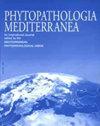“意大利”葡萄藤感染Esca病原体的生理反应
IF 1.9
3区 农林科学
Q2 AGRONOMY
引用次数: 5
摘要
研究了意大利普利亚一个20年的葡萄葡萄园的生理特征。对没有叶面症状和任何木材或浆果变化迹象的健康葡萄藤进行了调查,对天然木材感染了最小绿脓杆菌(同为嗜绿脓杆菌)和衣原孢子衣原球菌的葡萄藤进行了调查,这些葡萄藤显示出棕色木材条纹症状,以及自然感染了最小绿脓杆菌、衣原孢子衣原球菌和地中海富米特poria的葡萄藤进行了调查,这些葡萄藤显示出棕色木材条纹和白腐症状。在正常植株发芽时采集的出血木质部汁液中,总抗坏血酸含量最高,而发生褐条和白腐病的植株黏度系数、谷胱甘肽浓度和植物生长调节剂活性最高。与健康葡萄藤相比,在展开叶片、坐果、丛合和束成熟葡萄藤生长阶段取样的受影响葡萄藤的叶片,其鲜重和干重、总叶绿素浓度减少,叶表面积增加。抗坏血酸和还原性谷胱甘肽浓度低,氧化还原状态弱,脱氢抗坏血酸和氧化性谷胱甘肽水平中等。分析还发现,脱氢抗坏血酸还原酶、抗坏血酸自由基还原酶和谷胱甘肽还原酶的活性降低。与脂质过氧化有关的细胞膜损伤与高过氧化氢浓度相结合。这些变化可能导致叶片细胞死亡和叶片症状的发展。抗坏血酸-谷胱甘肽循环支持葡萄对Esca复合物相关真菌的敏感性。本文章由计算机程序翻译,如有差异,请以英文原文为准。
Physiological responses of ‘Italia’ grapevines infected with Esca pathogens
Physiological features were examined of a 20-year-old Vitis vinifera ‘Italia’ table grape vineyard cropped in Apulia, Italy. Healthy vines with no foliar symptoms and any indications of wood or berry alterations, vines with natural wood infections by Phaeoacremonium minimum (syn. P. aleophilum) and Phaeomoniella chlamydospora showing brown wood streaking symptoms, and vines naturally infected with P. minimum, P. chlamydospora and Fomitiporia mediterranea with brown wood streaking and white rot symptoms, were surveyed. Bleeding xylem sap, collected at bud-break from healthy vines showed the greatest total ascorbic acid level, while vines with brown wood streaking and white rot had the greatest viscosity coefficient, glutathione concentration, and plant growth regulator activities. Compared to healthy vines, leaves of wood affected vines, sampled during the unfolded leaf, fruit setting, cluster closing and bunch ripening vine growth stages, had reduced fresh and dry weights, total chlorophyll concentrations, and increased leaf surface area. Low ascorbic acid and reduced glutathione concentrations, weak redox state, and moderate levels of dehydroascorbic acid and oxidized glutathione were also detected in these vines. Analyses also detected reduced activities of dehydroascorbate reductase, ascorbate free radical reductase and glutathione reductase in diseased vines. The cell membrane damage, associated with lipid peroxidation, was coupled with high hydrogen peroxide concentrations. These changes could contribute to the cell death of leaves and foliar symptom development. The ascorbate-glutathione cycle supports grapevine susceptibility to Esca complex-associated fungi.
求助全文
通过发布文献求助,成功后即可免费获取论文全文。
去求助
来源期刊

Phytopathologia Mediterranea
生物-植物科学
CiteScore
4.40
自引率
8.30%
发文量
28
审稿时长
6-12 weeks
期刊介绍:
Phytopathologia Mediterranea is an international journal edited by the Mediterranean Phytopathological Union. The journal’s mission is the promotion of plant health for Mediterranean crops, climate and regions, safe food production, and the transfer of new knowledge on plant diseases and their sustainable management.
The journal deals with all areas of plant pathology, including etiology, epidemiology, disease control, biochemical and physiological aspects, and utilization of molecular technologies. All types of plant pathogens are covered, including fungi, oomycetes, nematodes, protozoa, bacteria, phytoplasmas, viruses, and viroids. The journal also gives a special attention to research on mycotoxins, biological and integrated management of plant diseases, and the use of natural substances in disease and weed control. The journal focuses on pathology of Mediterranean crops grown throughout the world.
The Editorial Board of Phytopathologia Mediterranea has recently been reorganised, under two Editors-in-Chief and with an increased number of editors.
 求助内容:
求助内容: 应助结果提醒方式:
应助结果提醒方式:


